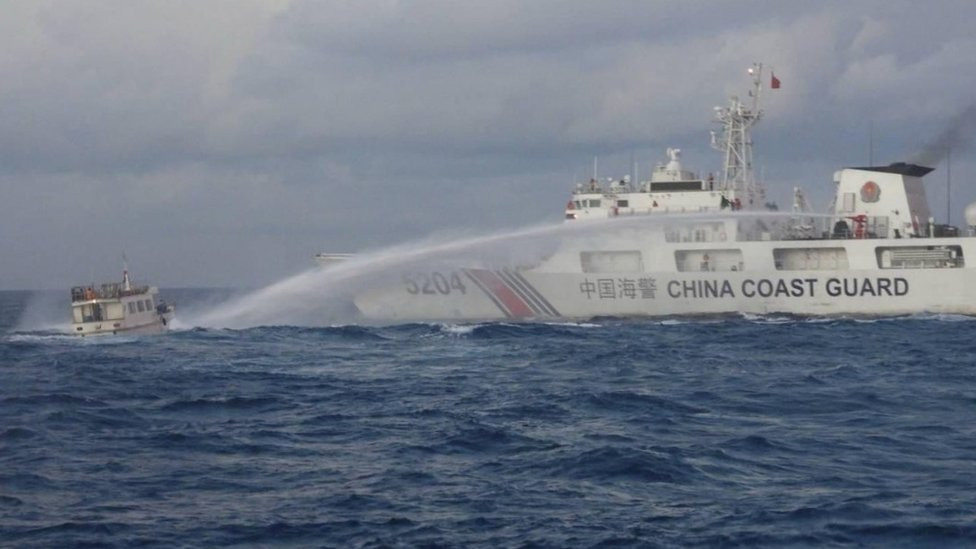The South China Sea has once again become a flashpoint for tensions between China and the Philippines, with ships from both countries colliding near a disputed reef. This latest incident, which occurred early on Monday, comes after a brief period of easing relations and a “provisional arrangement” aimed at ending altercations over the Second Thomas Shoal, where Manila has been resupplying troops stationed on a grounded warship.
The collision took place at Sabina Shoal, a contested feature in the Spratly Islands that lies about 86 miles west of the Philippine island of Palawan, within the Philippines’ internationally recognized exclusive economic zone. Both countries blame each other for the incident, with China accusing the Philippine vessels of “illegally intruding” and “deliberately colliding” with its ships, while Manila accuses Beijing’s vessels of conducting “unlawful and aggressive maneuvers” that resulted in damage to two of its Coast Guard ships.
The Collision at Sabina Shoal
The collision occurred as the Chinese coast guard intercepted a pair of Philippine Coast Guard cutters near Sabina Shoal, a feature located within the Philippines’ internationally recognized exclusive economic zone. Beijing has been criticized for its aggressive actions in the South China Sea, which it claims almost entirely, despite a 2016 international court ruling rejecting its claim. Manila has maintained a weekslong coast guard presence at Sabina Shoal, leading to heightened tensions with China.
The Chinese coast guard, in its statement, alleged that Philippine vessels had “illegally” entered the waters near the atoll and deliberately rammed a Chinese ship. Manila disputed this account, stating that its vessels were on a resupply mission to personnel stationed on Flat Island when they encountered the Chinese ships. They also shared photos showing “minor structural damage” sustained by the two ships in the collisions. Both countries have accused each other of “dangerous” and “aggressive” maneuvers, highlighting the precarious nature of the situation.
US Response and the Mutual Defense Treaty
Washington has responded to the collision, reminding Beijing of the U.S.'s 73-year-old Mutual Defense Treaty with the Philippines. In a statement, Vedant Patel, a U.S. State Department spokesperson, reiterated that Article IV of the treaty extends to armed attacks on Philippine armed forces, public vessels, or aircraft, including those of its Coast Guard, anywhere in the South China Sea. This response demonstrates the U.S.'s commitment to its alliance with the Philippines and its willingness to intervene if necessary.
Tensions Rise as China Steps Up Its Presence
Tensions between China and the Philippines have been rising in recent months, with a series of incidents, including collisions, unsafe approaches, and water cannon blasts, occurring near South China Sea hotspots. China has been increasing its military presence in the region, with its largest coast guard ship being parked off Sabina Shoal for about a month before being replaced by another vessel. Ships belonging to China’s so-called maritime militia have also been seen in the area, further raising concerns about China's intentions.
The collision at Sabina Shoal is the latest in a series of incidents that have heightened tensions in the South China Sea. The incident has also raised concerns about the potential for a larger conflict, with the Philippines' President Ferdinand Marcos Jr. stating in May that a “willful act” resulting in the death of a Philippine national would almost certainly be a red line. While both sides have sought to de-escalate the situation, the collision serves as a stark reminder of the potential for conflict in the region, highlighting the importance of diplomatic efforts to resolve the long-standing disputes and ensure maritime stability.
A New Front in the Dispute
The collision at Sabina Shoal has “opened up a new front” in the territorial dispute between China and the Philippines, according to Ray Powell, director of Stanford University’s SeaLight Project. While the Second Thomas Shoal has been a primary point of contention for years, the emergence of Sabina Shoal as a new flashpoint signifies a potential escalation of the dispute. This could lead to further confrontations and increase the risk of miscalculation, potentially escalating into a larger conflict. The situation underscores the need for both countries to engage in open dialogue and seek peaceful resolutions to the disputes, prioritizing the stability of the region over territorial claims.
The Importance of Diplomacy
The incident at Sabina Shoal highlights the importance of diplomacy and international cooperation in resolving territorial disputes. Both China and the Philippines should engage in dialogue and explore solutions that adhere to international law, such as the United Nations Convention on the Law of the Sea. The international community also has a role to play in fostering dialogue and ensuring that all parties involved act responsibly and refrain from actions that could escalate tensions. Maintaining peace and stability in the South China Sea is crucial for regional security and prosperity, and the avoidance of conflict should be a priority for all parties involved. The future of this critical waterway depends on the willingness of all actors to engage in constructive dialogue and find peaceful solutions to their disputes.
The Potential for Further Escalation
The collision at Sabina Shoal, despite both sides seeking to de-escalate, has raised concerns about the potential for further escalation. The increased militarization of the South China Sea, coupled with the territorial disputes and the heightened rhetoric from both sides, creates a volatile situation where a miscalculation or misunderstanding could easily lead to a larger conflict. While a full-scale military conflict remains unlikely, the potential for a significant escalation in tensions is a real concern. The international community must remain vigilant and encourage both China and the Philippines to engage in dialogue, reduce tensions, and find peaceful solutions to their disputes.
A Long-Standing Dispute with Potential for Crisis
The collision at Sabina Shoal, while a recent incident, is part of a long-standing territorial dispute between China and the Philippines. This dispute, which centers on the South China Sea, has been a source of tension for decades. China claims almost the entire South China Sea, including the waters around Sabina Shoal, based on its so-called nine-dash line. This claim, however, has been rejected by an international court ruling in 2016. The Philippines, along with several other Southeast Asian nations, contests China's claim and asserts its own sovereignty over portions of the South China Sea. The recent collision, along with other incidents in the region, underscores the complexity of the situation and the potential for a wider conflict. The need for diplomatic solutions and peaceful resolution remains paramount to maintaining stability in the region.
Conclusion: A Looming Shadow of Conflict
The collision at Sabina Shoal is a stark reminder of the ongoing tensions and potential for conflict in the South China Sea. The incident has highlighted the importance of diplomacy, international cooperation, and a commitment to peaceful resolution of disputes. While the immediate fallout of the collision remains to be seen, the incident serves as a reminder of the delicate balance of power in the region and the potential for a significant escalation in tensions. The future of this strategically vital waterway will depend on the willingness of all actors to prioritize dialogue, restraint, and the pursuit of peaceful solutions.

















